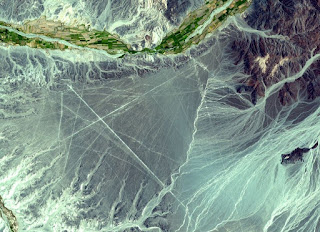Chapter 1
On a rainless plain, called the pampas in Peru, the ancient inhabitants etched gigantic lines, geometric forms, and naturalistic drawings called geoglyphs on the surface of the desert by sweeping the iron oxide rocks aside on the desert floor to reveal the lighter sand beneath. The ancient inhabitants can clearly be linked to the Nazca culture, for they are nearly identical to the motifs present on the Nazca ceramics or pottery. The function of the bimorphs -the hummingbirds, spider, pelican, killer whales, lizards and monkey among others-seems to be religious; they graphically represent some of the supernatural forces of the Nazca religion.
A high altittude view of the Nazca Lines
It is not surprising that there is no mention of these geoglyphs in the Spanish colonial reports. This would not have been important to them. It was not until 1926 that the American archeologist Alfred Kroeber drew what may be the earliest plans of Nazca’s geoglyphs and noted how they were made by removing the surface rock.
Drawings of Nazca Geoglyphs
He described the “ray roads” radiating out from the island-like rocky knolls, what are called today “ray centers.” In 1927 Torbio Mejia Xessepe observed the long lines, trapezoids, and general zigzags on the hillsides of the valleys of the Rio Grande de Nazca drainage on the plain. He interpreted them as “seques” or “religious roads.” Due to the environment much of the Nazca beliefs centered around agriculture and fertility. The Nazca religion depicted powerful nature-gods, such as the mythical killer whale, the harvesters, the mythical spotted cat, the serpentine creature the most prevalent figures, the anthropomorphic mythical beings ( that of human form or human attributes as opposed to that of animals or divine beings). ` The total prehistoric sequence in Peru spans 15,000 years, starting about 13,000 B.C. when the first hunter-gather societies left their traces in the Ayocucho and Ancash areas. The Lauricocho culture began in the preceramic period ca. 8000 B.C
Lauricocha Remains
The Lauricocho culture had three periods:
Period I. 8000-6000 B.C.
Period II. 6000-4200 B.C.
Period III. 4200-2500 B.C
The Lauricocho culture was part of the prehistoric people that settled in the rock caves in Lauricocho, Pacaicasa, and Guitarrero.
Lauricocha Rock Caves
The oldest human complex society in Peru and the Americas, the Norte Chico civilization flourished along the Pacific coast between 3000-1500 B.C This civilization had a complex Pre-Columbian society that included 30 population centers, they also built pyramids, some of which are thought too be 5,000 years old, built into the Peruvian Descent.
Norte Chico Pyramids in northern Peru
The Chavin diety Lanzon
The culture directly affecting the Nazca was the Paracas culture, which existed from about 800-175 B.C. and then merged with the Nazca. Both the Paracas and the Nazca cultures were located in the Ica Region of Peru. The language spoken was probably some early form of Quechua by the Nazca. The Nazca culture had long disappeared by the time of the Incas ca. 1200 A.D.(by at least 450 years).






No comments:
Post a Comment